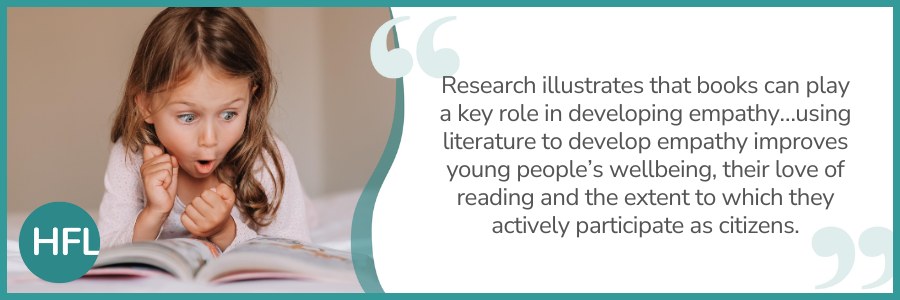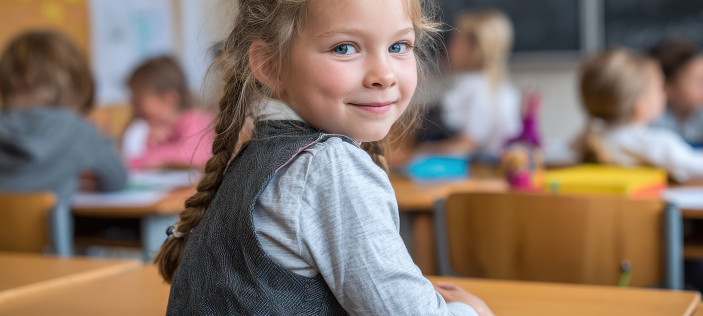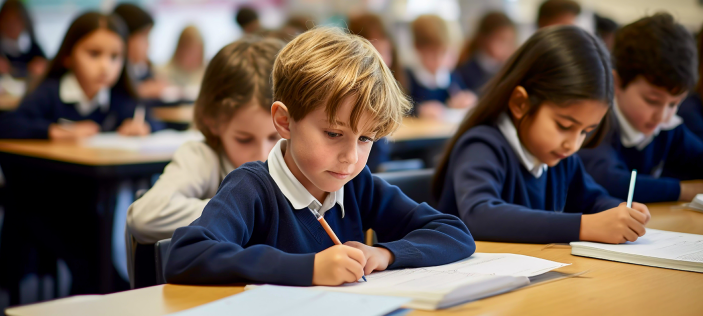
Empathy Day is on Thursday 6th June 2024 and forms part of Empathy Lab’s year long programme. Considering that this is now quite an established national day (running since 2019) I felt almost embarrassed that it had not crossed my path until now! So therefore, I felt compelled to find out more and most importantly examine the role books and reading have to play in supporting empathy development in children.
Empathy is our ability to experience and understand someone else’s feelings. Some people have the notion that empathy is something that you either have or you don’t, but in fact that couldn’t be any further from the truth. Research shows that empathy is a learnable skill and therefore something which can be actively taught.
Research illustrates that books can play a key role in developing empathy. Empathy Lab says that using literature to develop empathy improves young people’s wellbeing, their love of reading and the extent to which they actively participate as citizens – just a few of the added benefits! Empathy Lab’s Mission Empathy Challenge involves three steps: read, connect and act. The ‘read’ part consists of taking a dip into the carefully selected Read for Empathy book collection.
The 2024 Read for Empathy book collection consists of 40 recommended books for 3-11-year-olds, and 25 for 12-16-year-olds chosen by an expert panel (including Professor of Education, Teresa Cremin, who will speak at HFL’s upcoming September INSET event, and Jake Hope, Reading Development & Children's Book Consultant). It features major authors including Neil Gaiman, Jeffrey Boakye, Children’s Laureate Joseph Coelho, Hannah Gold, Phil Earle and Nadia Shireen. It includes picture books, novels, poetry, non-fiction, graphic and verse novels. Each book offers young people different ways of experiencing, understanding and building empathy. Several explore the world’s big empathy issues, including war, climate change and the refugee crisis. Others help children understand different cultures and identities, name and share their emotions and gain insight into a range of life circumstances.
Within the primary book collection (for 3-11 year-olds), eight powerful picture books have been selected specifically to help young readers understand their own and other people’s emotions. For example, Blue by Sarah Christou explores feelings of sadness and Geoffrey Gets the Jitters by Nadia Shireen explores anxiety. The Spaces In Between by Jaspreet Kaur & Manjit Thapp identifies mindful places that can be found (even in the city), where emotions can be pacified. Another selection of picture books opens up exploration for older readers as they tackle some hard-hitting topics such as wartime trauma (My Baba’s Garden by Jordan Scott and Sydney Smith); loss of a family member (Grandpa and the Kingfisher by Anna Wilson and Sarah Massini); and the experience of refugees (To the Other Side by Erika Meza). There is also an insightful picture book titled Gina Kaminski Saves the Wolf by Craig Barr-Green and Francis Martin that captures the experiences of a girl, who is autistic, working through the challenges of school, and delivers her own unique perspective on Little Red Riding Hood .
Additionally, there is a great selection of early readers (simple, short chapter books with illustrations) within the primary book collection, including a dyslexia friendly book Dimple and the Boo by Pip Jones which is about a little gnome navigating his way through his emotions of anger and worry. Similarly, The Girl Who Became a Fish by Polly Ho-Yen explores the fears overcome by its central character Ita, who has moved to a new town.
Poetry, non-fiction, and a couple of graphic novels have also been selected within the book collection. My Heart is a Poem is a touching poetry anthology that encapsulates an array of human feelings and emotions, beautifully illustrated, and features the work of top poets such as Mandy Coe, Joseph Coelho, Karl Nova and Debjani Chatterjee. All Bodies Are Wonderful by Beth Cox is a positive and reassuring non-fiction book exploring diversity (as recommended by HFL’s adviser Nicky in her book of the month). A depiction of empathy as a driving force to save lives, at the risk of your own, is brought to life by graphic novel, It’s Her Story: Irena Sendler by Margaret Littman. It is the remarkable true story of a Catholic social worker who supported Jewish families in the ghettos of Poland during World War Two.
The novels chosen in the book collection designed for older readers, deal with a variety of different life experiences and the complexities that can accompany them. For example, understanding the experience of people living with challenging life circumstances is tackled in How to be More by Anne-Marie Conway where the main character struggles with a stammer. Finding Bear by Hannah Gold focuses on one of the world’s big empathy issues: earth’s creatures who are faced with the difficulties of climate change.
Imagine if you could hold the power to change the hearts and minds of the lives of the children and young people around you. Change the way we think and feel, and in real ways, we start to change the world. With the Read for Empathy collection 2024, that power truly does lie in your hands.
Jake Hope, Reading Development & Children's Book Consultant.
Empathy Day is open to all to get involved and inspired. Schools and libraries can register for free Mission Empathy resources. Everyone can also enjoy a free online festival, on the day and on demand, featuring live events from some of the amazing authors and illustrators included in the book collection.
I hope you can dive into some of these activities and reading materials to develop the empathy skills of the children you teach! We’d love to hear about how you’ve used the resources both on 6th June and throughout the year.
The books that form the primary book collection have been listed in this useful guide on the Empathy Lab website.



